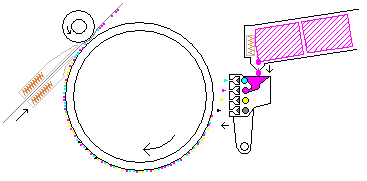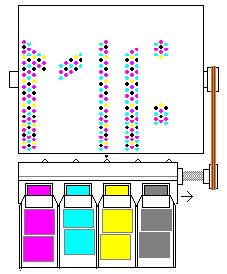| Printer Maintenance & Consumeables Printers > | Navigation Icons Guide
|
Solid Ink Printer Mechanism

Ink sticks are supplied in a chute at the right of the picture.
At the end of the chute a melter liquifies the ink as neeeded.
The printhead is a pagewidth assembly. Colour models have a column of four printhead jet elements for each position so that they can paint any pixel position on the drum with any (or all) the colours.
The printhead is heated to aboutt 135 centigrade in operation so that ink is liquid with low viscosity, allowing small drops to be formed in in the jet elements. When the printer is idle at night and at the weekend the printer may reduce head temperature so that the ink is just above freezing - this allows it a quick start without having to purge solidified ink.
Jet elements are piezoelectric running at about 24kHz. The intention is that phaser heads should last a "lifetime". They aren't in contact with anything so as long as there is no contamination there is no specific reason why an element should fail.
The head assembly usually contains thousands of elements in columns. A printhead could have as many or as few jet element columns as a design calls for depending on the tradeoff between cost and speed the designers want.
The drum holds the page image being worked on and the printhead steps across painting colums of microscopic colour dots.

The drum is heated to about 65 centigrade, just below the melting point of the ink, but a point at which it is still malleable. The drum usually has an anodized aluminium surface. The drum surface may be very slightly oiled with silicone oil to ensure that ink does not stick too firmly.
After the number of turns needed to build a page the transfer roller engages and the drum turns once more. This time as it does so paper is fed through a pre-heater bringing its surface temperature up to match that of the drum. Pressure from the transfer roller shifts the image from the lose bonding with the oiled drum surface to a firm bonding with the paper, which cools and the ink sets firmly in place.
After a maintenance cycle to ensure the drum is cleaned and re-oiled the printer is ready for the next page.
Fairly small printers are achieving speeds of up to 50 pages per minute.



